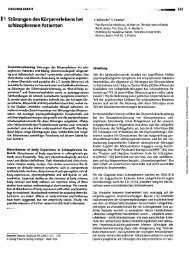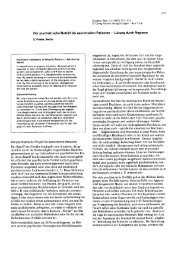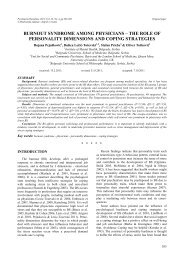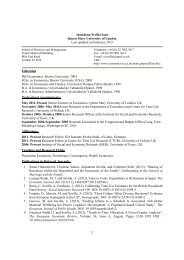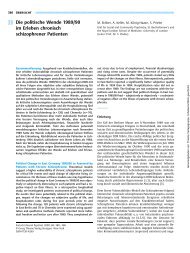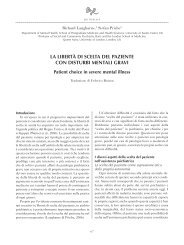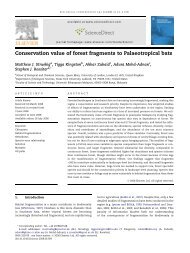Proofs - Personal Webspace for QMUL - Queen Mary, University of ...
Proofs - Personal Webspace for QMUL - Queen Mary, University of ...
Proofs - Personal Webspace for QMUL - Queen Mary, University of ...
Create successful ePaper yourself
Turn your PDF publications into a flip-book with our unique Google optimized e-Paper software.
S60 U. Kluge et al. / European Psychiatry 27 (2012) / supplement n°2 / S56-S62<br />
eight services (37%) reported having none, while data from fi ve<br />
services (2%) were not available to report. In summary, <strong>for</strong> the 126<br />
(54%) out <strong>of</strong> the 235 providers <strong>for</strong> which data were available, either<br />
no staff with an immigrant background were employed in the<br />
service or only one member <strong>of</strong> staff with an immigrant background.<br />
In Sweden, all services reported having some immigrant<br />
members <strong>of</strong> staff, followed by Belgium, the Netherlands and<br />
the UK (14 out <strong>of</strong> 15 services interviewed), whereas in Lithuania<br />
none <strong>of</strong> the services reported having immigrants among their<br />
staff members. These differences did not appear to be related<br />
to variations between countries in terms <strong>of</strong> service size. The<br />
percentage <strong>of</strong> services that employed immigrants among their<br />
staff members was considerably higher within mental health<br />
services and emergency departments, than in primary care<br />
services (see Table 3 <strong>for</strong> fi gures by service type).<br />
7. Discussion<br />
7.1. Main fi ndings<br />
This study highlights the diffi culty in investigating service<br />
use by immigrant patients, due to limited availability <strong>of</strong> data on<br />
service use <strong>for</strong> all patients in most <strong>of</strong> the participating countries,<br />
and across the three different types <strong>of</strong> health service investigated.<br />
In nearly half <strong>of</strong> the participating European countries, none <strong>of</strong><br />
the services studied had any data available, and the availability<br />
<strong>of</strong> data registers <strong>for</strong> immigrant patients was much smaller. Only<br />
15% <strong>of</strong> the services interviewed held any fi gures <strong>for</strong> service use<br />
by immigrant patients that were based on actual data. In most<br />
cases, the data were unavailable or based purely on estimates.<br />
These fi ndings could be attributed to lower immigration rates <strong>for</strong><br />
some European counties, or the view that collecting such data<br />
on immigrant patients might be regarded as discriminating or<br />
is not considered as necessary <strong>for</strong> planning service provision.<br />
Alternatively, some services and countries may consider current<br />
service provision as suitable <strong>for</strong> meeting the needs <strong>of</strong> immigrant<br />
patients, or that the needs <strong>of</strong> immigrant patients do not differ<br />
greatly from those <strong>of</strong> nationals.<br />
In terms <strong>of</strong> specifi c provisions, the availability and use <strong>of</strong><br />
interpreting services seemed generally low [5], particularly in<br />
primary care where only a few services reported using either<br />
direct interpreting, or telephone interpreting services. More<br />
than half <strong>of</strong> the assessed services did not provide any direct<br />
interpreting service. Telephone interpreting services were even<br />
less <strong>of</strong>ten available than direct interpreting services. Considering<br />
the lower cost and the relative convenience <strong>of</strong> organising tel-<br />
Table 3<br />
Responses given <strong>for</strong> whether immigrants were among staff members<br />
employed by services.<br />
Service type Immigrants among staff employed<br />
by the service<br />
Yes No<br />
Primary care (n=142) 54% (77) 46% (65)<br />
Emergency care (n=47) 74% (35) 26% (12)<br />
Mental health care (n=46) 76% (35) 24% (11)<br />
ephone interpretation, it is surprising that telephone services<br />
are not more widely used.<br />
There was also considerable variation between countries<br />
in the use <strong>of</strong> the different types <strong>of</strong> interpreting services (direct,<br />
telephone, and mixed). Mental health services tended to provide<br />
more direct interpreting services, than did primary care services<br />
and emergency departments. These fi ndings refl ect the structure<br />
<strong>of</strong> the services and the methods they apply to diagnose and<br />
treat patients. Longer treatment periods with longer contact<br />
sessions with single patients, and a lower case- load af<strong>for</strong>ds<br />
greater benefi ts from using more direct interpreting services.<br />
Where communication timing is more critical, as is <strong>of</strong>ten the case<br />
in emergency departments, then telephone interpreting services<br />
<strong>of</strong>fer more distinct advantages and are there<strong>for</strong>e more widely<br />
used. The choice <strong>of</strong> interpreting service needs to compliment<br />
the way services actually function, in order to provide a suitable<br />
and effective health care.<br />
For the Scandinavian countries participating in the study,<br />
Spain, the UK, and the Netherlands, interpreting services tended<br />
to be more mainstreamed in their delivery <strong>for</strong> immigrant patients.<br />
This was quite different <strong>for</strong> Austria, Finland, Greece and Lithuania,<br />
where there was either no interpreting services available or<br />
only very few services. For Finland and Lithuania, this could<br />
be attributed to immigration and health service provision <strong>for</strong><br />
immigrants being a relatively new issue <strong>for</strong> policy and practice,<br />
but this would not explain the case <strong>for</strong> Austria. While <strong>for</strong> Denmark,<br />
Finland, Sweden, Spain and the UK, there were regulations and<br />
policies concerning the costs <strong>of</strong> interpretation. This is not the case<br />
<strong>for</strong> Austria and Germany, where the costs are not covered by state<br />
funds or health insurance regulation [21]. In the Netherlands,<br />
interpreting services have been provided free by the government<br />
since 1985, but these subsidies are to be abolished from 2012 [28].<br />
The data presented here indicate wide heterogeneity<br />
between the 16 countries and the three types <strong>of</strong> services studied<br />
in terms <strong>of</strong> the provision <strong>of</strong> services <strong>for</strong> immigrant patients.<br />
Some <strong>of</strong> the data seemed to suggest that countries with fewer<br />
individuals from immigrant backgrounds tended to have fewer<br />
immigrant staff members employed within their services. Also<br />
to test this hypothesis further, research is required to compare<br />
these data with data on the different backgrounds <strong>of</strong> immigrant<br />
groups served within the catchment areas <strong>of</strong> these services.<br />
<strong>Pro<strong>of</strong>s</strong><br />
7.2. Comparison with literature<br />
In keeping with previous studies, our data confi rms that<br />
very little data is available on the use <strong>of</strong> health services by<br />
immigrant patients. Unlike the study conducted by Nielsen et<br />
al. [29], which surveyed national statistics agencies and relevant<br />
national health authorities, the EUGATE study was based on a<br />
direct assessment <strong>of</strong> service provision. These two approaches <strong>for</strong><br />
gathering in<strong>for</strong>mation on the use <strong>of</strong> health services by immigrant<br />
patients yielded similar results. But Nielsen et al. found registry<br />
data on the utilization <strong>of</strong> health services at least in 11 European<br />
countries (Austria, Belgium, Denmark, Finland, Greece, Italy,<br />
Luxembourg, the Netherlands, Poland, Slovenia and Sweden).<br />
Austria, Belgium, Denmark and the Netherlands were included<br />
in the EUGATE study, but no registry data were available at the<br />
service provider level <strong>for</strong> these four countries.




